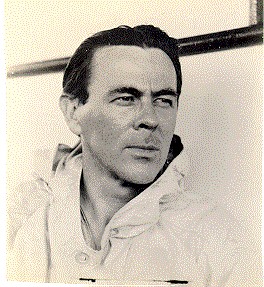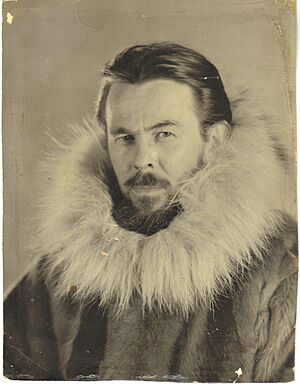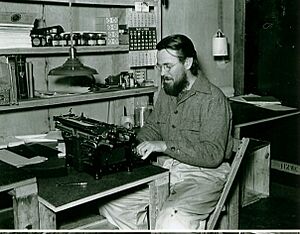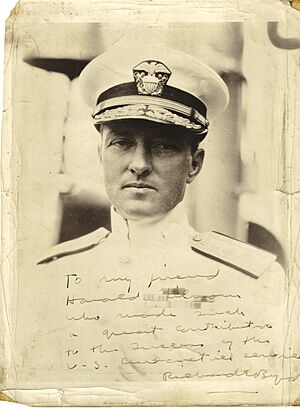Harold P. Gilmour facts for kids
Harold Parker Gilmour (born March 19, 1903 – died April 16, 1969) was a brave volunteer explorer. He joined the 1939–1941 Byrd Polar Expedition to Antarctica. He worked for the United States Antarctic Service (USAS) for very little pay. A mountain in Antarctica, Mount Gilmour, is named after him to honor his work.
Contents
Exploring Antarctica
Harold P. Gilmour, often called "Gil," was an important assistant to the expedition's leader, Rear Admiral Richard E. Byrd. Gil was also the official note-taker and historian for the trip. He kept a daily official diary of everything that happened. This started when they sailed on the USMS North Star on November 21, 1939, from Philadelphia. The ship had left Boston earlier to prepare for the long journey. In Philadelphia, they loaded two planes. One was a small Beechcraft plane, and the other was a larger Condor plane. These planes would help with exploring.
Gilmour's official notes are now kept safe in the National Archives in Washington, D.C. He also kept a personal diary. This unofficial diary was much more detailed. It shared personal stories about the challenges the explorers faced. This personal diary is now with Gilmour's children.
His Role on the Expedition
Gilmour was born in Lynn, Massachusetts. As a teenager, he joined the Navy and later left with good standing. In his mid-thirties, Gilmour decided he wanted an adventure. He volunteered to join the United States Antarctic Service (USAS). He became an explorer for the 1939–1941 expedition to the South Pole. He was assigned to Little America III, which was called the West Base.
During the long, dark winter of 1940, a special group was formed at the West Base. This group was called the Geological Party Expedition. Four men prepared for a very long journey by dog sled. They planned to travel to the Edsel Ford Ranges. The four members were Lawrence A. Warner, who was the leader and a geologist. Charles F. Passel was another geologist and also handled the radio. Harold P. Gilmour, "Gil," was the note-taker and collected plant and animal samples. Loran Wells, known as "Joe," was the photographer and observer. The large Warpasgiljo Glacier was later discovered. It was named after these four men (WARner + PASsel + GILmour + JOe).
The Geological Party's Journey
The Geological Party explored and mapped much of the southern part of the Edsel Ford Range. They also looked for different natural resources in the area. They carefully measured the land to help create better maps of the region. The four-man Geological Party Expedition left the West Base on October 17, 1940. They returned 82 days later, on January 7, 1941. They traveled a total of 691 miles using their dog sleds.
Early in this almost three-month trip, one of Gilmour's wooden skis broke. He could not fix it. So, Gilmour continued with only half a ski. The other explorers nicknamed him "Ski-and-a-Half Gilmour." This extra effort on one leg caused Gilmour to limp for the rest of his life. He also had two toes removed because of frostbite. This was something that often happened to explorers back then.
During their nearly three-month journey, airplanes helped them by dropping supplies. These supplies were left every 100 miles along their path. The Geological Party Expedition visited about 50 peaks in this region for the first time. They also collected about 300 rock and soil samples. Mount Gilmour was one of these peaks. It was named in honor of Harold P. Gilmour.
Awards and Recognition
Gilmour received an Antarctic Expedition Medal (a gold version). He earned this award for his volunteer work. He was the Administrative Assistant and official note-taker and historian. He worked for Rear Admiral Richard E. Byrd during the 1939–1941 Polar Exploration to Antarctica. The United States Congress approved this medal on September 24, 1945. The medal was given to Gilmour in Santiago, Chile. The US Ambassador Claude G. Bowers presented it to him.
His Family Life
Harold P. Gilmour was first married to Agnes Vinson. They later divorced. They had three children together:
- Gloria Gilmour
- Ruth Marie Gilmour
- Phillip "Buddy" Gilmour
On the way back home from Antarctica, the USS Bear stopped in Valparaíso, Chile. There, Gilmour met María Teresa Correa Santa Cruz at a US Consulate party. She was from a well-known family in Viña del Mar, Chile. Nine months later, she traveled to Oxford, Ohio, with her uncle. They were married on April 24, 1942. Together, they had three children:
- Cynthia L. Gilmour, born June 24, 1947, died September 19, 2002. She had two children: Christopher Harrison Gilmour and Francisca Frias Gilmour. Rear Admiral Richard E. Byrd was Cynthia's godfather.
- Gregory D. Gilmour, born January 1, 1954. He has two children: Gregory D. Gilmour Jr. and Ashley Victoria Gilmour.
- Noel M. Gilmour, born in 1956. He has three children: Nicolas Ferre Gilmour, Alexander Ferre Gilmour, and Zachary Ferre Gilmour.
Later Life and Passing
Gilmour passed away in Viña del Mar, Chile, when he was 66 years old. He is buried at Cemetery Number 1 in Valparaíso, Chile. This historical cemetery overlooks the beautiful Bay of Valparaíso.





